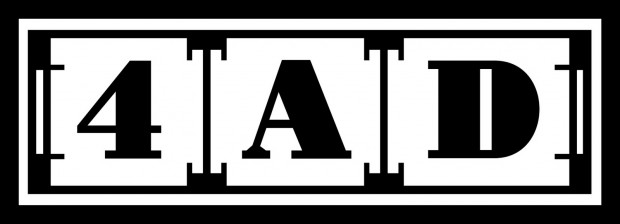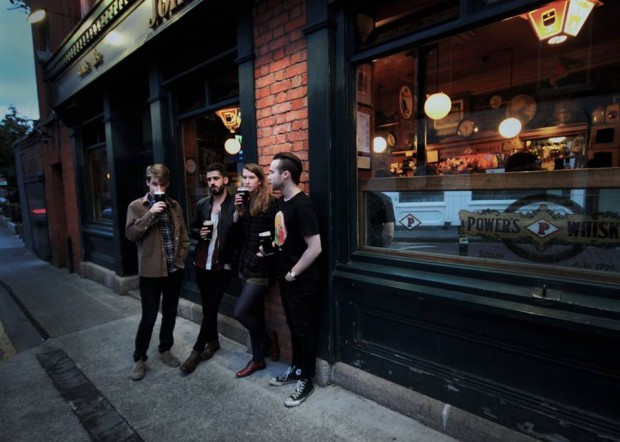A label based on aesthetic principles, 4AD has spent over 30 years being everything you think it is not. Initially founded by Ivo Watts Russell in 1980 as a vehicle to release music by bands at the centre of the nascent goth scene, the label quickly established a style and format that would lead to it becoming one of the most iconic record labels of the 80s.
With records clad in immaculate Vaughn Oliver sleeves, the label originally specialised in floaty, gothic ambience, before encompassing world music, dance music, and – perhaps most significantly – the cutting edge of the US college rock scene.
For a label with such an overtly strong theme, it has a surprisingly diverse roster, and below is a ten track sampler that really is the tip of the iceberg when it comes to this powerhouse of independent music.
1. The Birthday Party – Deep in the Woods (1983)
By the time Australian ex-pats The Birthday Party had decamped to Berlin, the writing was on the wall. With the violence of their music easily matching the outright warfare of their live shows, the band released two records in 1983, one for Mute, and the other for 4AD. Both are essential, capturing the writing of Nick Cave as it transformed from post-punk aggression into Biblical epiphany. This haunting track prefigures Cave’s later position as a fine writer of murder songs, and finds him unleashing terrible violence upon the object of his desires, before dumping her in a well. The song erupts in the apocalyptic tumult of Rowland S. Howard’s guitar, and the band broke up shortly after, nothing left to say.
2. The Cocteau Twins – Pearly Dewdrops Drop (1984)
Emerging from Grangemouth in Scotland, The Cocteau Twins are perhaps the band most closely associated with the label. In their wake, countless other bands attempted to create haunting, swirling guitar soundscapes, but none could quite match the ethereal beauty of Elizabeth Fraser, Robin Guthrie, and Simon Raymonde. Quickly establishing themselves as 4AD’s flagship band, they left in 1990 to release two underwhelming albums, before calling it a day. ‘Pearly-Dewdrops Drop’ captures the band on a fulcrum, finally leaving behind the dark gothic inspirations of their past, and embarking on a glittering psychedelic future.
3. This Mortal Coil – Song to the Siren (1983)
Not content with releasing all this beautifully crafted and packaged music, Ivo Watts Russell made the leap to music maker himself with the This Mortal Coil project. Not quite band, not quite label showcase, it established itself as a collective of people involved on the label, with Watts Russell at the centre. Across three records of expertly chosen cover songs, as well as atmospheric original material, they became a one-stop-shop for everything that was good about 4AD, providing a jumping-off point for so much other music. This is the highpoint, a cover of Tim Buckley’s 1969 song that eclipses the original, as well as carving out a ground all of its own. Largely the work of the Cocteau Twins, it stands alone from their work, proving them as more than one-trick ponies.
4. Dead Can Dance – Dawn of the Iconoclast (1987)
Behind the Cocteau Twins in terms of sales and influence, Dead Can Dance nonetheless carved out an incredible career in music, drawing together world music, ancient folk forms, goth ambience, and everything else that works, to create a loose style that found them appealing to fans of new age classical music, as well as indie fans. By 1987, the core duo of Brendan Perry and Lisa Gerrard were at the peak of their abilities, crafting pieces like ‘Dawn of the Iconoclast’ which defy easy categorisation. They disbanded at the end of the 90s, before getting back together a few years ago, with Gerrard picking up a Golden Globe for the soundtrack to Gladiator along the way.
5. Pixies – Monkey Gone to Heaven (1989)
After being saddled with the ‘goth’ tag by the music press (not unjustifiably, it must be said) the label turned more than a few heads when it appeared to leave behind the UK in favour of the loud, noisy sounds emerging from the American college rock scene. Surfer Rosa had a seismic impact when it was released in 1988, establishing Pixies as one of the most exciting and original bands in the world, and a year later Doolittle appeared cementing their reputation as the band of the future, inspiring countless other bands, much as the Cocteau Twins did a few years earlier. ‘Monkey Gone to Heaven’ is a highpoint, showcasing the pop dynamic of the band, the noise, and – of course – the scream that echoed around the world.
6. Throwing Muses – Bea (1989)
The other key name in 4AD’s American invasion was Throwing Muses, led by Kristen Hersh and Tanya Donnelly. Much more fractured and jagged than Pixies, the band were a big critical hit right from their first album in 1986, but the commercial success their rivals flirted with continually eluded them. When the band originally disbanded in 1997, Hersh was more successful as a solo artist, whilst Donnelly was better known for the more straightforward and grungy Belly. But 1989’s Hunkpapa finds them both working in perfect unison, creating a strange brew of melodicism and confusion that sounds just as fresh now as it did at the time.
7. Red House Painters – Grace Cathedral Park (1993)
Pure emotional devastation. San Francisco’s Red House Painters were led by Mark Kozelek, a man unafraid to pour his feelings directly into the music, devoid of metaphor or craft. Disarmingly frank, the band immediately made a huge impact on the UK music scene, with their desolate creations finding firm home in the music press, meriting comparisons to the likes of Nick Drake or Neil Young. A bittersweet pill to swallow, the band’s 4AD albums are beautiful and unflinchingly raw, full of the kind of personal detail that most songwriters stray away from. Their debut full-length album, known by the roller-coaster on the cover, remains their best, with the music rising to meet the impossible challenge offered by the music.
8. TV on the Radio – Staring at the Sun (2004)
The mid-90s represented the end of the ‘classic’ period for the label, and for a few years it languished in obscurity, a shadow of its former self. Watts Russell had left, and it seemed that the direction had left with him. Cue a series of key releases in the early 2000s, and it seemed like 4AD was right back at the forefront of independent music, with TV on the Radio leading the vanguard. Equal parts Sonic Youth and soul music, the band reflected the diversity and confusion of post- 9/11 New York, and their debut album Desperate Youth, Blood Thirsty Babes established them as one of the most unique bands on the planet. Subsequent albums would tighten the songwriting and have greater impact, but lack the freshness of this unique opening statement.
9. Bon Iver – Skinny Love (2008)
4AD seemed like a natural home for Bon Iver’s Justin Vernon, his sad songs of love and hope drawing a clear line back to those of Mark Kozelek. Independently made, but released by the label, For Emma, Forever Ago was one of those zeitgeist albums, returning the acoustic guitar and confessional songwriting back to the heart of the mainstream. Recorded in a log cabin in the woods, and oozing that mercurial quality of ‘authenticity’, it likewise launched a thousand imitators and remains the de-facto album of choice for those who have been wounded in the name of love.
10. Ariel Pink’s Haunted Graffiti – Round and Round (2010)
On the face of it, Ariel Pink seems like an odd fit for the label, his trashy, lo-fi aesthetic being about as far away from their mid-80s style as it was possible to be. But drawing a line back to Nick Cave’s junkyard religious sermons back at the very beginning, Ariel Pink is all about the song, and his kaleidoscopic playfulness has come to be one of the most distinctive sounds of the last few years. ‘Round and Round’ is his crowning achievement to date, a perfect pop song of deceptive simplicity that has clawed its way into the great pantheon of popular music.






